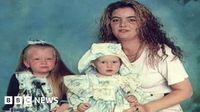In the heart of Wales, two haunting cases have resurfaced in the public consciousness—each marked by tragedy, unanswered questions, and the relentless march of forensic science. Decades after the crimes, the stories of Karen Price and Diane Jones, along with her young daughters, continue to echo through the streets of Cardiff and Merthyr Tydfil, reminding communities of the enduring pain of unresolved loss and the hope that new technology might finally bring long-awaited answers.
The first of these cases, the murder of Karen Price, is as chilling as it is emblematic of its era. Karen was just 15 years old when she vanished in July 1981, having run away from the Maes-Yr-Eglwys Assessment Centre in Church Village, Rhondda Cynon Taf. Her life had been fraught with instability—her parents’ divorce, a turbulent upbringing, and repeated absconding from care. By the time she disappeared for good, no one was actively searching for her. She was, as crime reporter Tom Bedford described to BBC, “Little Miss Nobody.”
For eight long years, Karen’s fate was a mystery. That changed on December 7, 1989, when two builders renovating a property at 29 Fitzhamon Embankment in Cardiff made a grim discovery. Digging just three feet into the earth, they unearthed a rolled-up carpet. At first, they joked about the possibility of a body inside. But their shock was real when they found skeletal remains, wrists bound with electrical flex and a plastic bag over the head, as reported by BBC. The body was so decomposed that, according to police, determining the cause of death was “impossible.”
The investigation that followed was hampered by the era’s lack of CCTV and the destruction of evidence caused by ongoing building work. Yet, it would become a landmark in the use of forensic science in Wales. Maggot activity in the carpet allowed experts to narrow the window of Karen’s death to between July 1981 and March 1982. Forensic dentist Professor David Whittaker used tooth analysis to confirm the victim’s sex and age, and found evidence of violent death. The case was so unusual for Cardiff at the time that former detective Jeff Norman told BBC, “There weren’t that many murders in Cardiff. I’d never seen a skeleton before, so it was quite a shock.”
With no missing person report to match the remains, detectives turned to innovative methods. Facial reconstruction artist Richard Neave built a model of Karen’s appearance from her skull, a technique considered groundbreaking at the time. The image was broadcast on Crimewatch on February 15, 1990. It was a long shot, but it worked: two social workers from Pontypridd recognized Karen and came forward. DNA extracted from Karen’s bones then confirmed her identity, matching her to her parents for the first time.
The Crimewatch appeal did more than identify the victim—it prompted a confession. Idris Ali, watching the program, confessed to being involved in Karen’s murder. He described how Alan Charlton, who lived in the basement flat where Karen’s body was found, ordered Karen and another girl to strip for photographs. When the other girl refused, Charlton attacked her. Karen intervened, only to become the focus of Charlton’s violence. Ali, then 16, said he held Karen’s hands “for a very short time” under threat, while Charlton continued to beat her. When Charlton stopped, Karen was unresponsive and bleeding from the mouth. Ali admitted to helping wrap Karen’s body in carpet and later burying her in a shallow grave outside the flat’s kitchen window.
Alan Charlton, described by prosecutors as “a psychopath,” was convicted of Karen’s murder in 1991 and sentenced to life in prison. He served 26 years before being released on parole in 2017. Ali, who pleaded guilty to a lesser charge, claimed he did so only to be released from prison. The case’s resolution brought some closure to Karen’s family, but not without lasting scars. Karen’s mother, Anita Edward, struggled to cope with her daughter’s death and died in 1992 from acute alcohol intoxication. Her father, Leonard Michael Price, reflected, “It’s been sad for the family, at least she’s at rest and at peace, and they got what they deserve.”
Despite the eventual convictions, the case remains a stark reminder of the failures of the era: Karen was never listed as missing, and her mother’s inquiries to social services reportedly went unanswered. As Tom Bedford put it, “For a young girl to die in that way, her life snuffed out at the age of 15, it’s just too sad for words.” Yet, Karen’s case also stands as a testament to the power of forensic innovation and public appeals in solving even the coldest of cases.
Meanwhile, in Merthyr Tydfil, another tragedy from the 1990s is being re-examined. On October 11, 1995, Diane Jones, just 21, and her daughters Shauna, aged two, and Sarah-Jane, 13 months, died when their home on the Gurnos estate was deliberately set ablaze. The triple murder sent shockwaves through the community and led to a controversial investigation. Annette Hewins was convicted of arson with intent to endanger life in 1997, but her conviction was quashed in 1999 after she had served two and a half years. Donna Clarke’s conviction was also overturned, and Denise Sullivan’s sentence for perverting the course of justice was reduced on appeal.
Years later, the shadow of the case still looms large. South Wales Police have now begun a forensic review, using new technology and techniques that were unavailable at the time of the original investigation. Detective Chief Inspector Gareth Davies told BBC, “Our hope is that we can uncover new evidence which will give us the breakthrough we need to find who was responsible.” He remains optimistic that someone with vital information might finally come forward. “Three decades have passed – that person may now be in different circumstances. It is never too late to come forward.”
The pain for Diane’s surviving family is still raw. Her sister Mary said, “In October 1995 my heart, my life got shattered into a million pieces. We didn’t just lose a sister and our nieces, we also lost our parents. It absolutely broke their hearts.” Diane’s father, John, took his own life in 2003, and her mother, Myra, died from cancer without seeing justice. The family still hopes for answers, and a balloon release in memory of Diane, Shauna, and Sarah-Jane is planned for October 11, 2025, at the family memorial stone on the Gurnos estate.
Both cases have left indelible marks on their communities, not only for the brutality of the crimes but also for the failures and breakthroughs in their investigations. They are reminders that even after decades, the pursuit of justice and closure continues—driven by advances in forensic science, persistent investigators, and the enduring love of families who refuse to forget.




